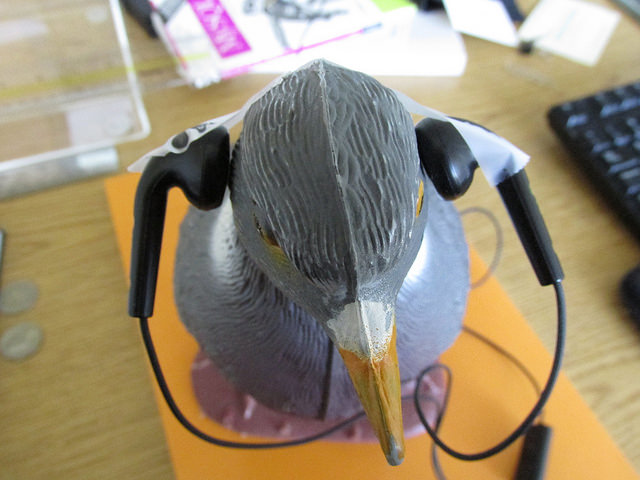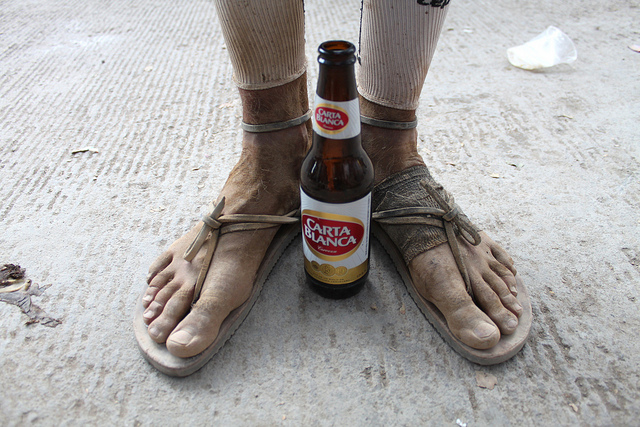Archive for the ‘Motivation’ Category
Be done with the past.
 The past has past, never to come again. But if you tell yourself old stories the past is still with you. If you hold onto your past it colors what you see, shapes what you think and silently governs what you do. Not skillful, not helpful. Old stories are old because things have changed. The old plays won’t work. The rules are different, the players are different, the situation is different. And you are different, unless you hold onto the past.
The past has past, never to come again. But if you tell yourself old stories the past is still with you. If you hold onto your past it colors what you see, shapes what you think and silently governs what you do. Not skillful, not helpful. Old stories are old because things have changed. The old plays won’t work. The rules are different, the players are different, the situation is different. And you are different, unless you hold onto the past.
As a tactic we hold onto the past because of aversion to what’s going on around us. Like an ostrich we bury our head in the sands of the past to protect ourselves from unpleasant weather buffeting us in the now. But there’s no protection. Grasping tightly to the past does nothing more than stop us in our tracks.
If you grasp too tightly to tired technology it’s game over. And it’s the same with your tired business model – grasp too tightly and get run through by an upstart. But for someone who wants to make a meaningful difference, what are the two things that are sacred? The successful technology and successful business model.
It’s difficult for an organization to decide if the successful technology should be reused or replaced. The easy decision is to reuse it. New products come faster, fewer resources are needed because the hard engineering work has been done and the technical and execution risks are lower. The difficult decision is to scrap the old and develop the new. The smart decision is to do both. Launch products with the old technology while working feverishly to obsolete it. These days the half-life of technology is short. It’s always the right time to develop new technology.
The business model is even more difficult to scrap. It cuts across every team and every function. It’s how the company did its work. It’s how the company made its name. It’s how the company made its money. It’s how families paid their mortgages. It’s grasping to the past success of the business model that makes it almost impossible to obsolete.
People grasp onto the past for protection and companies are nothing more than a loosely connected network of people systems. And these people systems have a shared past and a good memory. It’s no wonder why old technologies and business models stick around longer than they should.
To let go of the past people must see things as they are. That’s a slow process that starts with a clear-eyed assessment today’s landscapes. Make maps of the worldwide competitive landscape, intellectual property, worldwide regulatory legislation, emergent technologies (search YouTube) and the sea of crazy business models enabled by the cloud.
The best time to start the landscape analyses was two years ago, but the next best time to start is right now. Don’t wait.
Image credit – John Fife
What Innovation Feels Like
 There are countless books and articles on innovation. You can read how others have done it, what worked and what didn’t, how best to organize the company and how to define it. But I have not read much about how it feels to do innovation.
There are countless books and articles on innovation. You can read how others have done it, what worked and what didn’t, how best to organize the company and how to define it. But I have not read much about how it feels to do innovation.
Before anything meaningful can happen, there must be discontent or anger. And for that there needs to be a realization that doing things like last time is a bad idea. This realization is the natural outcome of looking deeply at how things really are and testing the assumptions of the status quo. And the best way to set all this in motion is to do things that generate immense boredom.
Boredom can be created in two ways. 1. Doing the same boring work in the same boring way. 2. Stopping all activity for 30 minutes a day and swimming in the sea of your boring thoughts. Both work well, but the second one works faster.
Next, with your discontent in hand, it’s time birth the right question. Some think this the time for answers, but with innovation the real work is to figure out the question. The discomfort of trying to discover the right question is seven times more uncomfortable the discomfort of figuring out the right answer. And once you have the right question, the organization rejects you as a heretic. If the organization doesn’t dismiss you in a visceral way, you know you don’t have the right question. You will feel afraid, but repeat the cycle until your question threatens the very thing that has made the company successful. When people treat you like you threaten them, you know you’re on to something.
To answer your question, you need help from the organization, but the organization withholds them from you. If you are ignored, blocked or discredited, you’re on the right path. Break the rules, disregard best practices, and partner with an old friend who trusts you. Together, rally against the organization and do the work to answer your question. If you feel isolated, keep going. You will feel afraid and you will second guess yourself. Proceed to the next step.
Make a prototype that shows the organization that your question has an answer. Don’t ask, just build. Show the prototype to three people and prepare for rejection. You and your prototype will be misunderstood and devalued. Not to worry, as this is a good sign. Revise the prototype and repeat.
Do anything you can to show the prototype to a customer. Video the customer as they interact with the prototype. You will feel afraid because you are breaking the rules. This is how you should feel. Keep going.
Set up a meeting with a leader who can allocate resources. If you have to, set up the meeting under false pretenses (the organization is still in rejection mode) and show the video. Because of the uncertainty of their response, you will feel afraid. Show the video anyway.
The organization is comfortable working in the domains of certainty and control, but innovation is done in the domain of uncertainty. By definition, the organization will reject your novel work. If you are rejected, keep going. Revise your heretical question, build a prototype to answer it, show a customer, show someone who can allocate resources, and be afraid all along the way. And repeat, as needed.
With innovation, mostly you feel afraid.
Image credit – Tybo
The Yin and Yang of Work
 Do good work and people will notice. Do work to get noticed and people will notice that too.
Do good work and people will notice. Do work to get noticed and people will notice that too.
Try to do good work and you’ll get ahead. Try to get ahead and you won’t.
If the work feels good while you’re doing it, it’s good work. If it doesn’t, it’s not.
If you watch the clock while you work, that says nothing about the clock.
When you surf the web at work, you’re not working. When you learn from blog posts, podcasts and TED talks, you are.
Using social media at work is good for business, except when it isn’t.
When you feel you don’t have the authority, you don’t. If you think you need authority, you shouldn’t.
When people seek your guidance you have something far more powerful than authority, you have trust.
Don’t pine for authority, earn the right to influence.
Influence is to authority as trust is to control.
Personal relationships are more powerful than org charts. Work the relationships, not the org chart.
There’s no reason to change right up until there’s a good reason. It may be too late, but at least you’ll have a reason.
Holding on to what you have comes at the expense of creating the future.
As a leader don’t take credit, take responsibility.
And when in doubt, try something.
Image credit — Peter Clark
There is no failure, there is only learning.
 You’re never really sure how your new project will turn out, unless you don’t try. Not trying is the only way to guarantee certainty – certainty that nothing good will come of it.
You’re never really sure how your new project will turn out, unless you don’t try. Not trying is the only way to guarantee certainty – certainty that nothing good will come of it.
There’s been a lot of talk about creating a culture where failure is accepted. But, failure will never be accepted, and nor should it be. Even the failing forward flavor won’t be tolerated. There’s a skunk-like stink to the word that cannot be cleansed. Failure, as a word, should be struck from the vernacular.
If you have a good plan and you execute it well, there can be no failure. The plan can deliver unanticipated results, but that’s not failure, that’s called learning. If the team runs the same experiment three times in a row, that, too, is not failure. That’s “not learning”. The not learning is a result of something, and that something should be pursued until you learn its name and address. And once named, made to go away.
When the proposed plan is reviewed and improved before it’s carried out, that’s not failure. That’s good process that creates good learning. If the plan is not reviewed, executed well and generates results less than anticipated, it’s not failure. You learned your process needs to change. Now it’s time to improve it.
When a good plan is executed poorly, there is no failure. You learned that one of your teams executed in a way that was different than your expectations. It’s time to learn why it went down as it did and why your expectations were the way they were. Learning on all fronts, failing on none.
Nothing good can come of using the f word, so don’t use it. Use “learn” instead. Don’t embrace failure, embrace learning. Don’t fail early and often, learn early and often. Don’t fail forward (whatever that is), just learn.
With failure there is fear of repercussion and a puckering on all fronts. With learning there is openness and opportunity. You choose the words, so choose wisely.
Image credit – IZATRINI.com
Diversity Through Podcasts
 Podcasts are short bursts of learning curated to please your ear. And with training budgets slashed, podcasts can be a wonderful and cost effective (free) way to learn.
Podcasts are short bursts of learning curated to please your ear. And with training budgets slashed, podcasts can be a wonderful and cost effective (free) way to learn.
The only way to battle uncertainty is to increase diversity. Bringing together people with diverse experiences lets us see things from multiple perspectives so we can better navigate uncertain terrain. But increasing your personal diversity helps too. Giving yourself new knowledge from diverse fields helps you broaden your perspective and makes you better at handling the uncertainty that comes with life.
The hard part about podcasts is deciding which ones to listen to. In my work to increase my diversity, I’ve listened to a lot of podcasts. Some were interesting and inspiring and others weren’t.
Below are some of my favorite podcast episodes. There’s a short description of each one, along with what I learned from them. Click the link to take you to the episode and you can listen to each one. No need to download. Just find the play button and click it.
Enjoy.
9-Volt Nirvana (Radiolab) — I learned about how the brain works and how it can be supercharged (with a 9-volt battery) to learn faster. I listened to this one on a long car ride with my daughter. She doesn’t like podcasts, but she was captivated by this one.
The Living Room (Love and Radio) — A story about how things can look differently than they are, especially when looking from the outside. I learned how our assumptions and the stories we tell ourselves shape how we see the world. This one is emotionally gripping.
Guided by Voices (Benjamin Walker’s Theory of Everything) — How Kant and Kepler both tried (and failed) to record the universal harmonies Pythagoras once heard. They struggled to make peace with the irrationality and disharmony of nature. I learned disharmony is natural and to embrace it. There’s a segment in the middle that’s not about Kant and Kepler that you may want to skip. To skip that segment, listen from the beginning and at 9:30 skip to 23:07 and listen to the end.
Eckhart Tolle’s The Power of Now (On Being) — I love Eckhart’s voice and his chuckle. I learned how I am not my emotions; I am the space for my emotions. And I learned about the Pain Body. That, on its own, was worth it. Krista Tippett is a brilliant interviewer.
Belt Buckle (Mystery Show) — A story about a long-lost belt buckle and its journey home. I learned how we attach meaning to objects, and that can be a good thing.
The Wrath of the Khans 1 (Dan Carlin’s Hardcore History) — This is a riveting story of Genghis Khan. Dan Carlin is wonderful – he sits you right in the middle of history. (Listen for two minutes and you’ll feel it.) I learned the power of personal will and how history changes over time. To skip Dan’s wonderful introduction and get a feel for the Great Khan, start at 19:00 and listen for 10 minutes. If you like what you hear, keep listening. This podcast is long almost 2 hours and it’s the first of a series of five on the Great Khan. This is one of my most favorite favorites.
image credit — mpclemens
Celebrating Six Years of Blog Posts
 Today marks six years of blog posts published every Wednesday evening. 300 weeks in a row and I haven’t skipped, forgot, or repeated. All written without an editor, though you knew that by the typos and grammar stumbles.
Today marks six years of blog posts published every Wednesday evening. 300 weeks in a row and I haven’t skipped, forgot, or repeated. All written without an editor, though you knew that by the typos and grammar stumbles.
It’s a challenge to write every week, but it’s worth it. Writing demands thinking things through, which can be difficult especially if you want to write clearly, but thinking things through creates knowledge. Deep knowledge.
Over the last year I wrote a lot about self-awareness, mindfulness and intentions. I’m better for my meditations, and through osmosis, so are some of the people closest to me. I expect you’ll hear more on these themes over the next year.
I’ve put myself out there with my writing. With some posts I’m afraid to hit the publish key, and those are the posts that matter. My fear is the signal there’s something important in the post. I hope to write more of those.
I strive to write clearly and densely and avoid buzzwords. Innovation is the buzzword that trips me up. But like He-Who-Shall-Not-Be-Named, I’ll see if I can avoid calling it by name. (And never three times in the same post.) And my call-to-arms will be clearer, plainer, denser.
I’m not sure what next year will bring, but I hope it will be 52 more posts.
Thanks for reading.
Mike
Image credit – Bart.
Accountability is not the answer.
 People have a natural bias toward doing what was done last time. The behavior is the result of untold generations that evolved to serve a single objective – to survive. Survival is about holding onto what is – protecting the family, providing food and waking up the next morning. In survival mode any energy spent on activities even partially unrelated to food, water and shelter is wasted energy. Any deviation from the worn path creates newness and uncertainty which causes adrenaline to flow and increases caloric burn rate. In survival mode the opportunity cost of those extra calories is larger than the potential benefit of a new experience.
People have a natural bias toward doing what was done last time. The behavior is the result of untold generations that evolved to serve a single objective – to survive. Survival is about holding onto what is – protecting the family, providing food and waking up the next morning. In survival mode any energy spent on activities even partially unrelated to food, water and shelter is wasted energy. Any deviation from the worn path creates newness and uncertainty which causes adrenaline to flow and increases caloric burn rate. In survival mode the opportunity cost of those extra calories is larger than the potential benefit of a new experience.
Today, calories are readily available for most and survival is no longer the objective, yet the bias persists. Today, the bias is not driven by a culture of survivability. It’s driven by a culture of accountability. Accountability forces its own singular focus – make the numbers – and, like survivability, tightly links the consequences of mistakes and shortcomings to the individual. Spend your calories any way you want just don’t miss the numbers.
In a culture of accountability there is no time to rest and recharge. Like the predator that never sleeps, metrics continually keep a hungry eye on the human prey. And like with food and water, any deviation from the worn path of increased throughput and profit is unsafe behavior.
But when the watering hole dries up and the fruit has been picked from the trees, the worn path isn’t the safest path. Frantic foraging is the only real option, but it’s not much safer and certainly no way to go through life. Paradoxically, a culture of accountability, with its intent of reducing the risk of missing the numbers can create far more dangerous failure modes. Where over fishing depletes the fish population and over farming makes for a dust bowl, over reliance on what worked last time can create failure modes that jeopardize survival.
To break the bias and help people do new things, measure new things and talk about new things. Start the next meeting with a review of what’s different. The team will feel energized. And after the discussion, adjourn the meeting because everything else is the same. At the next status meeting, talk only about the surprising insights. With the next email, send praise about the new learning. At team meetings, acknowledge the inherent uncertainty of doing new things and praise it over the potentially catastrophic consequences of over extending the tried-and-true. And for metrics, stop measuring outcomes.
Image credit — Applied Nomadology
Are you striving or thriving?
 Thriving is not striving. And they’re more than unrealated. They’re opposites.
Thriving is not striving. And they’re more than unrealated. They’re opposites.
Striving is about the now and what’s in it for me. Thriving is about the greater good and choosing – choosing to choose your own path and choosing to travel it in your own way. Thriving doesn’t thrive because outcomes fit with expectations. Thriving thrives on the journey.
Where striving comes at others’ expense, thriving comes at no one’s expense. Where striving strives on getting ahead, thriving thrives on growing. Striving looks outwardly, thriving looks inwardly. No two words are spelled so similarly yet contradict so vehemently.
Plants thrive when they’re put in the right growing conditions. They grow the way they were meant to grow and they don’t look back. They thrive because they don’t second guess themselves. If they don’t grow as tall as others, they’re happy for the tallest. And if they bloom bigger and brighter than the rest, they’re thoughtful enough to make conversation about other things.
Plants and animals don’t strive. Only people do. Strivers live their lives looking through the lens of the zero sum game. Strivers feel there’s not enough sunlight to go around so they reach and stretch and step on your head so they get a tan and leave you to supplement with vitamin D.
I can deal with strivers that tell you they’re going to step on your head and step on it just as they said. And I have immense disdain for strivers that pretend they’re sunflowers. But when I’m around thrivers I resonate.
Strivers suck energy from the room and thrivers give it way freely. And just as the bumblebee gets joy from spreading the love flower-to-flower, thrivers thrive more as they give more.
If you leave a meeting feeling good about yourself and three days later you rethink things and feel like a lesser person, you were victimized by a striver. If you feel great about yourself after a meeting and three days later feel even better, you rubbed shoulders with a thriver.
Learn to spot the strivers so you can distance yourself. And seek out the thrivers so you can grow with them.
Image credit Brad Smith
The Prerequisites for Greatness
 There are three prerequisites for greatness.
There are three prerequisites for greatness.
- You have to believe greatness is possible.
- You have to believe greatness is worth it.
- You have to believe you’re worthy of the journey.
If you can’t see old things in new ways, see new things in new ways, or see what’s missing, you won’t believe greatness is possible. To believe greatness is possible, you have to change your perspective.
Greatness is an uphill battle on all fronts, and to push through the pain requires weapons grade belief that it’s worth it. But the power isn’t in the payoff. The power is the personal meaning you attach to the work. Your slog toward greatness is powered from the inside out.
Here’s the tough one – you’ve got to believe you’re worthy of the journey. At every turn the status quo will kick you in the shins, and you must strap on your self-worth like shin guards. And when it’s time to conger greatness from gravel, you must believe, somehow, your life force will rise to the occasion. But, to be clear, you don’t have to believe you’ll be successful; you only have to believe you’re worth the bet.
From the outside, greatness is all about the work. But from the inside, greatness is all about you.
Image credit – Dietmar Temps
Mind-Body Motivation for Innovation
 Mind and body are connected, literally. It’s true – our necks bridge the gap. Don’t believe me? Locate one end of your neck and you’ll find your head or body; locate the other and you’ll find the other. And not only are they connected, they interact. Shared blood flows between the two and that means shared blood chemistry and shared oxygen. And not only is the plumbing shared, so is the electrical. The neck is the conduit for the nerves which pass information between the two and each communicate is done in a closed loop way. Because it’s so obvious, it sounds silly to describe the connectedness in this way, yet we still think of them as separate.
Mind and body are connected, literally. It’s true – our necks bridge the gap. Don’t believe me? Locate one end of your neck and you’ll find your head or body; locate the other and you’ll find the other. And not only are they connected, they interact. Shared blood flows between the two and that means shared blood chemistry and shared oxygen. And not only is the plumbing shared, so is the electrical. The neck is the conduit for the nerves which pass information between the two and each communicate is done in a closed loop way. Because it’s so obvious, it sounds silly to describe the connectedness in this way, yet we still think of them as separate.
When the mind-body is combined into a single element our perspectives change. For one, we realize the significance of the environment because wherever the body is the mind is. If your body walks your mind to a hot place, your body is hot and so is your mind. No big deal? Go to the beach in mid- summer, stand in the 105 degree heat for 1 hour, then do some heavy critical thinking. Whether the environment is emotionally hot or temperature hot, it won’t go well. Sit your body in a noisy, chaotic environment for two hours then try to come up with the new technology to keep your company solvent. Keep your body awake for 24 hours and try to solve a fundamental problem to reinvent your business model. I don’t think so.
Innovation is like a marathon, and if you treat your body like a marathon runner you’ll be in great shape to innovate. Get regular physical activity; eat well; get enough sleep; don’t go out and party every night; drink your fluids; don’t get over heated. If you don’t think any of this matters, do the opposite for a week or two and see how it goes with your innovation. And as with innovation climate, geography and environment matter. Train at altitude and sleep in a hypobaric chamber and your mind-body responds differently. Run up hill and you get faster on the hills and likely slower on the flats. Run downhill and your legs hurt. Run in sub-zero temperatures and your lungs burn.
Just as the mind goes with the body, the body follows mind. If you are anxious about your work, you feel a cold pressure in your chest – a clear example where your mental state influences your body. If you are depressed, your body can ache – another example where your mind changes your body. But it’s more than unpleasant body sensations. Your body does far more than move your head place-to-place. Your body is the antenna for the unsaid, and the unsaid is huge part of innovation. Imagine a presentation to your CEO where you describe your one year innovation project that came up empty. When you stop talking and there’s a minute of silent unsaid-ness, your body picks up the signals, not your mind. (You feel the tightness in your chest before you know why.) But if your mind has been monkeying with your body, your crumpled antenna may receive incorrect signals or may transmit them to your brain improperly, and when the CEO asks the hard question, your mind-body is spongy.
And what fuels the mind-body? Why does it get out of bed? Why does it want to do innovation? Dan Pink has it right – when it comes to tasks with high cognitive load, the mind-body is powered by autonomy, the pursuit of mastery, and purpose. For innovation, the mind-body is powered intrinsically, not extrinsically. If your engineers aren’t innovating, it’s because their mind-bodies know there’s no autonomy in the ether. If they’re not taking on the impossible, it’s because they aren’t given time to master its subject matter or the work they’re given is remedial. If they’re doing what they always did, it’s because their antennas aren’t resonating with the purpose behind the innovation work.
When your innovation work isn’t what you’d like it’s not a people problem, it’s an intrinsic motivation problem. Innovators’ mind-bodies desperately want to pole vault out of bed and innovate like nobody’s business, but they feel they have too little control over what they do and how they do it; they want to put all their life force into innovation, but they know (based on where their mind-bodies are) they’re not given the tools, time, and training to master their craft; and the rationale you’ve given them – the “WHY” in why they should innovate – is not meaningful to their mind-bodies.
Innovation is a full mind-body sport, and the importance of the body should be elevated. And if there’s one thing to focus on it’s the innovation environment in which the mind-body sits.
Innovators were born to innovate – our mind-bodies don’t have a choice. And if innovation is not happening it’s because extrinsic motivation strategies (carrots and sticks) are blocking the natural power of our intrinsic motivation. It’s time to figure that one out.
Image credit – Eli Duke
 Mike Shipulski
Mike Shipulski